Walkable Reading
Item set
- Title
- Description
- Date
- Contributor
- Format
- Language
- Type
- Coverage
-
Walkable Reading
-
"Walkable Reading" is audio tour of historic houses in Reading, Mass.
-
2010
-
Institution: Reading Public Library
-
audio/mpeg
-
image/jpeg
-
eng
-
sound recording-nonmusical
-
still image
-
Sound recordings
-
Photographs
-
Massachusetts--Middlesex (county)--Reading
Items
-
Bare Meadow Conservation AreaBare Meadow is a 125-acre site located in the northeast area of Reading. Bare Meadow was acquired from three major sources between 1972 and 1973. The largest parcel was a gift from Miriam Corey. More acreage was acquired from Reading residents, Mr. Bachelor and Mr. Zilano. The remainder of the land was acquired through smaller purchases. An additional 30 acres was added to Bare Meadow in 1983 by swapping a smaller parcel of highland with a citizen for a desired area. In 2007, the town purchased the abutting Mattera property at 1481 N. Main St., including a cabin. There are four entrances to Bare Meadow, all marked by large brown signs. The two primary entrances are off Pearl St. next to #717 and at the Mattera Cabin at 1481 North Main St. Both have ample off-street parking. The third is off Haverhill St. north of Batchelder Road. Parking is available on Batchelder Rd. The fourth is off Franklin Street next to the Wood End Cemetery. Parking is available in the cemetery and on Partridge Road. Bare Meadow includes a wonderful variety of terrain and plant communities. At the western end there are two small open meadows with long grasses, remnants of an apple orchard. In the center there are beautiful wooded areas and rocky hills with a network of trails that connect with the Northern Area Greenway. The property spans from Main Street to Haverhill Street. Many stone walls mark earlier farming uses of this land. Bare Meadow Brook flows through red maple swamps and open marshes on the western side and joins the Ipswich River at the northern end of the conservation lands. There are six certified vernal pools in Bare Meadow. Many plant species can be found here including lady slippers, partridge berry, marsh marigold, prince s pine, trout lily, witch hazel, and others. Wildlife is plentiful. There are white-tailed deer, red fox, coyote, raccoon, and others. It is a great area for bird-watching. The American woodcock nests here, and in the early spring it performs an amazing courtship flight over the two meadows. Great horned owls nest here and recently, Bluebirds have nested in the bluebird boxes installed in the meadow that can be viewed from a platform at the high spot of the meadow. Recent improvements to Bare Meadow have included the construction of a handicapped accessible trail running approximately 150 yards from the parking lot at the Mattera cabin to a new viewing platform constructed at the highest point overlooking the meadow. In addition, the trails have been cleared and improved with new blazes, boardwalks, signage, and maps. Bare Meadow is a wonderful place to visit year round. Spring brings the advent of wild flowers, nesting birds, and a chorus of frogs calling from the vernal pools. The beautiful oak and pine forest offer a respite from the hot summer days, while in the autumn, Bare Meadow comes alive with the colors of fall. During the winter, folks can enjoy sledding, snowshoeing, and cross-country skiing along the well-marked trails.
-
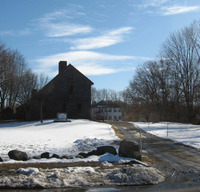 Parker Tavern : 103 Washington Street 103 Washington Street : Parker Tavern. This structure was not built by a Parker nor is it a tavern as we know them today, but it has a long and important history. The house dates from the earliest days of Reading, played an important role in the American Revolution, and even today serves to educate generations of school children. The structure has a stone foundation and wood shingles. It is the town's best-preserved example of the early, central-chimney, saltbox form of architecture. It has a simple Federal door surrounded with pilasters formed of recessed panels, capitals delineated by a narrow molding and shallow projection cornice. The windows are twelve over eight about the cornice. Its actual construction date is open to debate. Some historians feel the house was built in 1694 by Abraham Bryant Jr. and his wife Sarah. Other expert feel the style reflects 1724-25 architectural norms. The house passed from the Bryant family to Deacon Nathaniel Stow and then to Colonel Ebenezer Nichols and his son Ebenezer, Jr. in 1738. Col. Nichols served as an officer in 1722-1724 against the French and Indians and in the expedition against the French at Louisberg, Cape Breton, in 1745. He was in service at Cape Point and was wounded in the battle of Lake George. He became a colonel of a regiment under General Abercrombie at Ticonderoga in 1757, and sold his house the same year. Colonel Nichols is credited with drawing the earliest map of the town, was frequently town moderator and a selectman, and represented the town for nine years in the General Court. The "tavern" days came in Revolutionary times. Ephraim Parker opened the house to boarders and travelers. His most noteworthy tenant was Col. Archibald Campbell who had been taken prisoner after a brief skirmish in Boston Harbor and was held there for a time. Located on one of the original highways, delineated by Col. Nichols in 1764, the house was near a crossroads leading to present-day Wakefield and Woburn. In 1923 it was purchased by the Reading Antiquarian Society, which had the house restored by local architects, Adden and Parker. The society now maintains the tavern as a museum interpreting Reading's history. A caretaker is in residence in a modern structure attached to the house. It is visited each year by all third graders. It is also open to the general public several times a year.
Parker Tavern : 103 Washington Street 103 Washington Street : Parker Tavern. This structure was not built by a Parker nor is it a tavern as we know them today, but it has a long and important history. The house dates from the earliest days of Reading, played an important role in the American Revolution, and even today serves to educate generations of school children. The structure has a stone foundation and wood shingles. It is the town's best-preserved example of the early, central-chimney, saltbox form of architecture. It has a simple Federal door surrounded with pilasters formed of recessed panels, capitals delineated by a narrow molding and shallow projection cornice. The windows are twelve over eight about the cornice. Its actual construction date is open to debate. Some historians feel the house was built in 1694 by Abraham Bryant Jr. and his wife Sarah. Other expert feel the style reflects 1724-25 architectural norms. The house passed from the Bryant family to Deacon Nathaniel Stow and then to Colonel Ebenezer Nichols and his son Ebenezer, Jr. in 1738. Col. Nichols served as an officer in 1722-1724 against the French and Indians and in the expedition against the French at Louisberg, Cape Breton, in 1745. He was in service at Cape Point and was wounded in the battle of Lake George. He became a colonel of a regiment under General Abercrombie at Ticonderoga in 1757, and sold his house the same year. Colonel Nichols is credited with drawing the earliest map of the town, was frequently town moderator and a selectman, and represented the town for nine years in the General Court. The "tavern" days came in Revolutionary times. Ephraim Parker opened the house to boarders and travelers. His most noteworthy tenant was Col. Archibald Campbell who had been taken prisoner after a brief skirmish in Boston Harbor and was held there for a time. Located on one of the original highways, delineated by Col. Nichols in 1764, the house was near a crossroads leading to present-day Wakefield and Woburn. In 1923 it was purchased by the Reading Antiquarian Society, which had the house restored by local architects, Adden and Parker. The society now maintains the tavern as a museum interpreting Reading's history. A caretaker is in residence in a modern structure attached to the house. It is visited each year by all third graders. It is also open to the general public several times a year. -
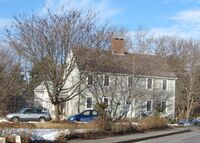 Old Nichols Home : 529 Franklin Street 529 Franklin Street : Old Nichols Home. Settlement in this area of Reading took place after the second land grants were distributed in 1686/7. John Nichols received a parcel at that time. He died in 1721 and probate records are unclear if he had built a house here. His son, Richard Nichols inherited the property but lived only 11 years longer, leaving the house and 143 acres of land to his heirs. A committee of appraisers chose to divide the extensive estate into three parts: Richard's widow receiving one third and two settlements from the remainder. Rather than dividing the land between the six children and therefore rendering it useless for subsistence farming, the eldest son, John, was given first choice of the two settlements. He chose this house including his mother's right to occupy one third, along with a portion of the land. The second oldest son named, Richard, accepted the land to the east where upon he built 483 Franklin Street. The two recipients were to pay their siblings proportionate shares from their father's liquid assets. One of the siblings was Sgt. Joshua Nichols who marched to the alarm of Ft. William Henry in 1757. Another relative, Loea Parker was born here and died at Ft. Independence in 1814. The typical farmhouse with the 5 windows across and a center chimney and entrance is much like its original configuration despite a fire in 1880 that threatened its existence. At that time the nearest fire alarm was on Lowell St. about a mile away, but it was successfully rung. Neighbors took the children to safety, saved much of the furniture and the volunteer fire fighters managed to save the home. The house was uninsured and the owners moved to another location. It is said that charred rafters could still be seen in the attic many years later.
Old Nichols Home : 529 Franklin Street 529 Franklin Street : Old Nichols Home. Settlement in this area of Reading took place after the second land grants were distributed in 1686/7. John Nichols received a parcel at that time. He died in 1721 and probate records are unclear if he had built a house here. His son, Richard Nichols inherited the property but lived only 11 years longer, leaving the house and 143 acres of land to his heirs. A committee of appraisers chose to divide the extensive estate into three parts: Richard's widow receiving one third and two settlements from the remainder. Rather than dividing the land between the six children and therefore rendering it useless for subsistence farming, the eldest son, John, was given first choice of the two settlements. He chose this house including his mother's right to occupy one third, along with a portion of the land. The second oldest son named, Richard, accepted the land to the east where upon he built 483 Franklin Street. The two recipients were to pay their siblings proportionate shares from their father's liquid assets. One of the siblings was Sgt. Joshua Nichols who marched to the alarm of Ft. William Henry in 1757. Another relative, Loea Parker was born here and died at Ft. Independence in 1814. The typical farmhouse with the 5 windows across and a center chimney and entrance is much like its original configuration despite a fire in 1880 that threatened its existence. At that time the nearest fire alarm was on Lowell St. about a mile away, but it was successfully rung. Neighbors took the children to safety, saved much of the furniture and the volunteer fire fighters managed to save the home. The house was uninsured and the owners moved to another location. It is said that charred rafters could still be seen in the attic many years later. -
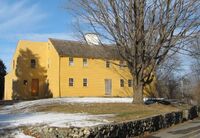 Richard Nichols House : 483 Franklin Street 483 Franklin Street : Richard Nichols House. As if the setting of this house on top of a high rise of land was not enough to catch a passerby's eye, then certainly the pumpkin colored facade makes the old dwelling stand out. Previous owners made the choice of color after extensive research revealed it was an appropriate hue. Those owners also stripped away layers of "improvements" to highlight the massive fireplaces in the center chimney and early wood paneling along with other restoration efforts. A new addition similar to a Beverly jog, can be seen set back from the main house to the west. The offset windows on the easterly end near the street side are evidence of an early extension to the original, traditional structure. Named for its first owner, Richard Nichols, the house is more than 250 years old and provided shelter to generations of Nicholses. Richard Nichols inherited this land division shortly after his father's death in 1732. It is assumed he immediately set out to build this house, for he was married in 1738. The property, and another adjacent Nichols homestead covered over 143 acres and was farmed well into the late 1800s. In 1893, the house was sold and the last of the Nichols family departed from the land of their forefathers. There is a Richard Nichols listed as serving at Lexington and Concord and another entry for Richard Nichols, Jr. as a member of the training band. Whether it is entries for the same person or a father and son, there is evidence that a member from this household took up arms to promote our freedom.
Richard Nichols House : 483 Franklin Street 483 Franklin Street : Richard Nichols House. As if the setting of this house on top of a high rise of land was not enough to catch a passerby's eye, then certainly the pumpkin colored facade makes the old dwelling stand out. Previous owners made the choice of color after extensive research revealed it was an appropriate hue. Those owners also stripped away layers of "improvements" to highlight the massive fireplaces in the center chimney and early wood paneling along with other restoration efforts. A new addition similar to a Beverly jog, can be seen set back from the main house to the west. The offset windows on the easterly end near the street side are evidence of an early extension to the original, traditional structure. Named for its first owner, Richard Nichols, the house is more than 250 years old and provided shelter to generations of Nicholses. Richard Nichols inherited this land division shortly after his father's death in 1732. It is assumed he immediately set out to build this house, for he was married in 1738. The property, and another adjacent Nichols homestead covered over 143 acres and was farmed well into the late 1800s. In 1893, the house was sold and the last of the Nichols family departed from the land of their forefathers. There is a Richard Nichols listed as serving at Lexington and Concord and another entry for Richard Nichols, Jr. as a member of the training band. Whether it is entries for the same person or a father and son, there is evidence that a member from this household took up arms to promote our freedom. -
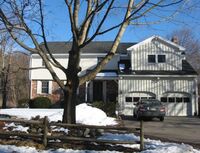 Early Parker House : 458 Franklin Street 458 Franklin Street : Now demolished. It seems a bit unusual to stop at an address that no longer exists and see two contemporary houses that replaced an old homestead. Although all vestiges of the past are erased from the site, the story of the place is of interest. In 1976 a major fire destroyed most of another early Parker house that had stood here for 250 years! This house sheltered several generations of Parkers and sent off two patriots one an experienced soldier and the other a fatherless 19-year-old boy. The 19 year old was Benjamin Parker, named for his father, Benjamin, who had served in the Colonial Wars in 1754. He died two years later leaving a widow and his 5-month-old son. The "experienced soldier" previously mentioned, was an uncle to the 19-year-old Benjamin. This uncle, Asa Parker, grew up in the house along with his brother, Benjamin and seven siblings. Asa was a corporal in the expedition to Crown Pt. in 1759 during the French and Indian War and carried the same rank on April 19, 1775. By 1869, the house left Parker family influence when it and 80 acres were sold to Henry Cook. Cook was a Civil War veteran and was a pallbearer at President Lincoln's funeral. An artist of some recognition, several of Cook's paintings still survive. He later moved to #326 Franklin St. and died in 1920 at the age of 85.
Early Parker House : 458 Franklin Street 458 Franklin Street : Now demolished. It seems a bit unusual to stop at an address that no longer exists and see two contemporary houses that replaced an old homestead. Although all vestiges of the past are erased from the site, the story of the place is of interest. In 1976 a major fire destroyed most of another early Parker house that had stood here for 250 years! This house sheltered several generations of Parkers and sent off two patriots one an experienced soldier and the other a fatherless 19-year-old boy. The 19 year old was Benjamin Parker, named for his father, Benjamin, who had served in the Colonial Wars in 1754. He died two years later leaving a widow and his 5-month-old son. The "experienced soldier" previously mentioned, was an uncle to the 19-year-old Benjamin. This uncle, Asa Parker, grew up in the house along with his brother, Benjamin and seven siblings. Asa was a corporal in the expedition to Crown Pt. in 1759 during the French and Indian War and carried the same rank on April 19, 1775. By 1869, the house left Parker family influence when it and 80 acres were sold to Henry Cook. Cook was a Civil War veteran and was a pallbearer at President Lincoln's funeral. An artist of some recognition, several of Cook's paintings still survive. He later moved to #326 Franklin St. and died in 1920 at the age of 85. -
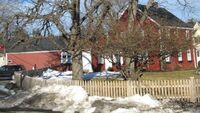 Joseph Parker House : 420 Franklin Street 420 Franklin Street. Surprisingly, Reading's earliest map drawn in 1765 does not show this house and yet historians believe it was built long before the map existed. Ownership can be traced back to the early 1700's when Joseph Parker married Elizabeth Eaton. Her brother died in Annapolis, Nova Scotia while on the expedition against the French in 1712 and his land was left to his brother-in-laws. (Women had no right to inheritance at the time.) It is assumed that the newly married couple set about building a house on the inherited land. The house is and was called a 'half-house', a rather rare structure today. Initially, a half house was built with anticipation that as the family and finances grew, the house would be expanded into the traditional home with 5 windows across the second floor, two windows flanking both sides of the front entrance door and a central chimney. The original facade facing Pasture Road (and facing to the south as most early houses did) has been altered through the years. The three windows on the second floor are in the position to accept a new 'half' with 2 more windows. The original door was under the off centered window above and has been changed to accommodate a first floor window. The Parkers never expanded their house despite raising 5 children here. One son, Ephraim, later became the innkeeper who lent his name to the Parker Tavern on Washington St. Ephraim was also a Minuteman who marched to Lexington and Concord, leaving from the Tavern along with his son, Ephraim Parker, Jr. They were aged 47 and 24 respectively. Joseph, a nephew of Ephraim was born in this house and was also a soldier in the Revolutionary War. He carried the name of his father and grandfather, the original Joseph Parker, who built the house. This Joseph left Reading on April 19th 1775 to march with other Reading Minutemen including his brother, Isaac. Joseph served for 5 days and later enlisted for a longer period when he was promoted to Corporal and later, Sergeant in 1777. Isaac Parker inherited the farm and 60 acres but sold it in 1800 after almost 100 years of Parker family ownership. The Nelson family also held the property for more than 100 years and the place was recognized as a Historic Homestead of Massachusetts in 2002. The late Fred Nelson accepted the certificate just one month before his 100th birthday! His wife, Ellen Nelson, was an artist, a sculptor of figurines, and founder of the Red Farm Studio card company. The house retains the same familiar red hued paint color today. New owners allowed the Historical Commission to observe recent renovations as some interior walls were peeled back revealing the many layers of history and changes. All the house lots on Pasture Road and Blueberry Lane were subdivided during the 20th century from the ancient Joseph Parker homesite.
Joseph Parker House : 420 Franklin Street 420 Franklin Street. Surprisingly, Reading's earliest map drawn in 1765 does not show this house and yet historians believe it was built long before the map existed. Ownership can be traced back to the early 1700's when Joseph Parker married Elizabeth Eaton. Her brother died in Annapolis, Nova Scotia while on the expedition against the French in 1712 and his land was left to his brother-in-laws. (Women had no right to inheritance at the time.) It is assumed that the newly married couple set about building a house on the inherited land. The house is and was called a 'half-house', a rather rare structure today. Initially, a half house was built with anticipation that as the family and finances grew, the house would be expanded into the traditional home with 5 windows across the second floor, two windows flanking both sides of the front entrance door and a central chimney. The original facade facing Pasture Road (and facing to the south as most early houses did) has been altered through the years. The three windows on the second floor are in the position to accept a new 'half' with 2 more windows. The original door was under the off centered window above and has been changed to accommodate a first floor window. The Parkers never expanded their house despite raising 5 children here. One son, Ephraim, later became the innkeeper who lent his name to the Parker Tavern on Washington St. Ephraim was also a Minuteman who marched to Lexington and Concord, leaving from the Tavern along with his son, Ephraim Parker, Jr. They were aged 47 and 24 respectively. Joseph, a nephew of Ephraim was born in this house and was also a soldier in the Revolutionary War. He carried the name of his father and grandfather, the original Joseph Parker, who built the house. This Joseph left Reading on April 19th 1775 to march with other Reading Minutemen including his brother, Isaac. Joseph served for 5 days and later enlisted for a longer period when he was promoted to Corporal and later, Sergeant in 1777. Isaac Parker inherited the farm and 60 acres but sold it in 1800 after almost 100 years of Parker family ownership. The Nelson family also held the property for more than 100 years and the place was recognized as a Historic Homestead of Massachusetts in 2002. The late Fred Nelson accepted the certificate just one month before his 100th birthday! His wife, Ellen Nelson, was an artist, a sculptor of figurines, and founder of the Red Farm Studio card company. The house retains the same familiar red hued paint color today. New owners allowed the Historical Commission to observe recent renovations as some interior walls were peeled back revealing the many layers of history and changes. All the house lots on Pasture Road and Blueberry Lane were subdivided during the 20th century from the ancient Joseph Parker homesite. -
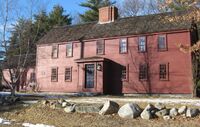 Foster-Emerson house : 409 Grove Street 409 Grove Street : The Foster-Emerson House. The home that now stands at 409 Grove Street was moved from its original location at 288 Grove Street in September of 1998. This house is often referred to as the Foster-Emerson house since three generations of Fosters and three generations of Emersons lived there. Samuel Foster and his wife Sarah came to Reading in 1709. He purchased land from John Brown and the house was built shortly thereafter. He and a son, Abraham, jointly owned a mill that later became the Slab City Saw Mill, one of two early mills in town. When Samuel died in 1762 he left his son and grandson, also Abraham, running the mill. Ebenezer Emerson purchased the house from Samuel's grandson in 1769. Ebenezer served in the Revolution under Captain Thomas Eaton. The Meadow Brook Golf Club, organized in 1898, bought farmland to develop the course and in 1912 purchased the Emerson house, barn and property. The house was used as a residence for the groundskeeper from 1923 until the early 1980's. The barn, used as the clubhouse burned in December of 1948 and a new clubhouse was built. In 1997, the golf club decided that it no longer needed the house. A town wide effort avoided demolition and a bidder was awarded the house and it was moved to its present location. The house, a two and a half story central chimney structure with an asymmetrical 6 bay facade, has undergone many alterations and additions, including partial removal and subsequent replacement of the central chimney. But, exposed framing members, visible in closets and upstairs rooms, indicate that the building retains most of its transitional First Period frame intact.
Foster-Emerson house : 409 Grove Street 409 Grove Street : The Foster-Emerson House. The home that now stands at 409 Grove Street was moved from its original location at 288 Grove Street in September of 1998. This house is often referred to as the Foster-Emerson house since three generations of Fosters and three generations of Emersons lived there. Samuel Foster and his wife Sarah came to Reading in 1709. He purchased land from John Brown and the house was built shortly thereafter. He and a son, Abraham, jointly owned a mill that later became the Slab City Saw Mill, one of two early mills in town. When Samuel died in 1762 he left his son and grandson, also Abraham, running the mill. Ebenezer Emerson purchased the house from Samuel's grandson in 1769. Ebenezer served in the Revolution under Captain Thomas Eaton. The Meadow Brook Golf Club, organized in 1898, bought farmland to develop the course and in 1912 purchased the Emerson house, barn and property. The house was used as a residence for the groundskeeper from 1923 until the early 1980's. The barn, used as the clubhouse burned in December of 1948 and a new clubhouse was built. In 1997, the golf club decided that it no longer needed the house. A town wide effort avoided demolition and a bidder was awarded the house and it was moved to its present location. The house, a two and a half story central chimney structure with an asymmetrical 6 bay facade, has undergone many alterations and additions, including partial removal and subsequent replacement of the central chimney. But, exposed framing members, visible in closets and upstairs rooms, indicate that the building retains most of its transitional First Period frame intact. -
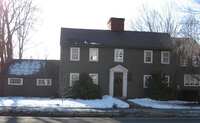 Bancroft homestead : 320 West Street 320 West Street : Bancroft Homestead. This home was built circa 1720, by a descendent of one of Reading's most famous families, the Bancrofts, who settled in Reading in 1673 on woodlots that their parents owned. The house was moved to this location from across the street in 1875. This is a classic "Salt Box" style, one of only three original saltbox styled houses in Reading. Historians have pieced together the history of this house from the will of Thomas Bancroft, Sr. and the marriage record for Thomas Jr. (who was actually the fourth of six Thomas Bancrofts to inhabit Reading). The land records are missing from when Thomas, Jr. married Lydia in 1717, but his father probably gave him the land to build the home now at 320 West Street. By 1730, when Thomas, Sr. died, he deeded additional land to Thomas Jr. as well as part of the yield of his orchard. "Since Thomas has no orchard of his own that bears fruit as yet, my will is my son Thomas shall have apples enough for 4 barrels of cider out of my orchard when it is bearing year and enough for two barrels when it is not the proper bearing year, which he shall have and enjoy for a term of 6 years after my decease." Thomas, Jr. and Lydia raised a family of eight children, one son, also named Thomas, was listed as an officer in the militia, and another son, Joseph, was a lieutenant in the Revolutionary War. Sons Joseph and Moses inherited the home by their father's will in 1747. Joseph inherited the north end of the home and of the chimney, as well as the east side of the cellar. Moses received the south end of the house to the middle of the chimney and the west side of the cellar. Moses moved to Sutton sometime between 1753 and 1756. The house passed through many hands, including three generations of Temples, until Abram Hale purchased land and house, and had the house moved in 1875 onto 16 acres of farmland that he owned. After being sold a number of times, in 1894 Mr. Smith P. Burton purchased it to add to his Elm Hill stock farm. The house was used to lodge hired hands on the farm and became run down. The house is an excellent example of early workmanship when timbers were cut by hand. It has a remarkably solid oak frame and benefited from extensive restoration done after 1932 when the McCabe's purchased the home. The McCabe's faithfully studied and finished the house with authentic touches and the center chimney, which had fallen down when the house was moved, was replaced in 1943.
Bancroft homestead : 320 West Street 320 West Street : Bancroft Homestead. This home was built circa 1720, by a descendent of one of Reading's most famous families, the Bancrofts, who settled in Reading in 1673 on woodlots that their parents owned. The house was moved to this location from across the street in 1875. This is a classic "Salt Box" style, one of only three original saltbox styled houses in Reading. Historians have pieced together the history of this house from the will of Thomas Bancroft, Sr. and the marriage record for Thomas Jr. (who was actually the fourth of six Thomas Bancrofts to inhabit Reading). The land records are missing from when Thomas, Jr. married Lydia in 1717, but his father probably gave him the land to build the home now at 320 West Street. By 1730, when Thomas, Sr. died, he deeded additional land to Thomas Jr. as well as part of the yield of his orchard. "Since Thomas has no orchard of his own that bears fruit as yet, my will is my son Thomas shall have apples enough for 4 barrels of cider out of my orchard when it is bearing year and enough for two barrels when it is not the proper bearing year, which he shall have and enjoy for a term of 6 years after my decease." Thomas, Jr. and Lydia raised a family of eight children, one son, also named Thomas, was listed as an officer in the militia, and another son, Joseph, was a lieutenant in the Revolutionary War. Sons Joseph and Moses inherited the home by their father's will in 1747. Joseph inherited the north end of the home and of the chimney, as well as the east side of the cellar. Moses received the south end of the house to the middle of the chimney and the west side of the cellar. Moses moved to Sutton sometime between 1753 and 1756. The house passed through many hands, including three generations of Temples, until Abram Hale purchased land and house, and had the house moved in 1875 onto 16 acres of farmland that he owned. After being sold a number of times, in 1894 Mr. Smith P. Burton purchased it to add to his Elm Hill stock farm. The house was used to lodge hired hands on the farm and became run down. The house is an excellent example of early workmanship when timbers were cut by hand. It has a remarkably solid oak frame and benefited from extensive restoration done after 1932 when the McCabe's purchased the home. The McCabe's faithfully studied and finished the house with authentic touches and the center chimney, which had fallen down when the house was moved, was replaced in 1943. -
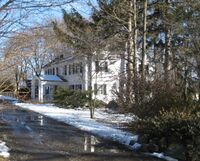 Eaton-Prescott farm : 284 Summer Avenue 284 Summer Avenue : Eaton-Prescott Farm. Originally situated on a 100 plus acre farm stretching from Woburn to Oak and West Street to Washington Street, this house sheltered a long line of the locally prominent Eaton family. Homesteaded before 1700 by John Felch, the land was bought by Thomas Eaton, a tanner and farmer, in 1712. It is believed that the original Eaton house was built one and a half stories high with a gambrel roof. Multiple renovations transformed the original home into the traditional Georgian style home with Greek Revival influence that we see today. Thomas Eaton expanded his land holdings and eventually gave parcels to his children where they settled with their families. Joshua Eaton, Jr. grew up in one of these homesteads. On April 19th, 1775, twenty-year-old Joshua Eaton, Jr. (grandson of Thomas Eaton) marched to Concord and Lexington with Captain John Bacheller's Minutemen and was later killed at the storming of Saratoga in 1777. He was the only Reading soldier to die in action during the Revolution. In 1948 the town voted to build a new elementary school at the site of his childhood home. The Joshua Eaton Elementary School was dedicated October 23rd, 1949. The original Eaton house was passed down through the generations and was eventually inherited by Abigail Eaton (great-granddaughter of Thomas Eaton). In 1813, Abigail was married to Joshua Prescott, a lawyer and graduate of Harvard University. He was a civic leader and served as counsel for citizens seeking to establish the Andover-Medford Turnpike (now Main Street). He is also credited with doing much to bring the railroad through Reading when the intention was to run the first branch through Woburn. Beginning in 1845, streets were laid out over the original farmlands, dividing the original farm into house lots. Stonewalls were taken for foundation stones of new homes. The Eaton-Prescott estate was finally sold out of Prescott ownership in 1902 when local architect Willard Adden purchased and remodeled the house adding an extension, garage, and dormers. Since then, owners have used a rear, north door as the main entrance.
Eaton-Prescott farm : 284 Summer Avenue 284 Summer Avenue : Eaton-Prescott Farm. Originally situated on a 100 plus acre farm stretching from Woburn to Oak and West Street to Washington Street, this house sheltered a long line of the locally prominent Eaton family. Homesteaded before 1700 by John Felch, the land was bought by Thomas Eaton, a tanner and farmer, in 1712. It is believed that the original Eaton house was built one and a half stories high with a gambrel roof. Multiple renovations transformed the original home into the traditional Georgian style home with Greek Revival influence that we see today. Thomas Eaton expanded his land holdings and eventually gave parcels to his children where they settled with their families. Joshua Eaton, Jr. grew up in one of these homesteads. On April 19th, 1775, twenty-year-old Joshua Eaton, Jr. (grandson of Thomas Eaton) marched to Concord and Lexington with Captain John Bacheller's Minutemen and was later killed at the storming of Saratoga in 1777. He was the only Reading soldier to die in action during the Revolution. In 1948 the town voted to build a new elementary school at the site of his childhood home. The Joshua Eaton Elementary School was dedicated October 23rd, 1949. The original Eaton house was passed down through the generations and was eventually inherited by Abigail Eaton (great-granddaughter of Thomas Eaton). In 1813, Abigail was married to Joshua Prescott, a lawyer and graduate of Harvard University. He was a civic leader and served as counsel for citizens seeking to establish the Andover-Medford Turnpike (now Main Street). He is also credited with doing much to bring the railroad through Reading when the intention was to run the first branch through Woburn. Beginning in 1845, streets were laid out over the original farmlands, dividing the original farm into house lots. Stonewalls were taken for foundation stones of new homes. The Eaton-Prescott estate was finally sold out of Prescott ownership in 1902 when local architect Willard Adden purchased and remodeled the house adding an extension, garage, and dormers. Since then, owners have used a rear, north door as the main entrance. -
 Samuel Bancroft house : 232 West Street 232 West Street : Samuel Bancroft House. This property was part of a farm pieced together by Henry Merrow over the years between 1652 and 1681. The farm was well situated on fertile land between "two highways", which survive today as County Road and West Street. The home is a Georgian style of colonial dwelling, but with a modern bay window added on the east side and porch and portico on the south. Samuel Bancroft, Jr. purchased the land from Henry's grandson in 1748, and it is thought he may have enlarged part of Merrow's previous dwelling and located it near the road that led from Woburn to the meetinghouse and village now Woburn Street. Samuel Bancroft came from a prominent family, many of whom settled in Reading. He was captain of the Militia in 1757 for the relief of Fort William Henry on Lake George. He also served as a Reading Selectman and in the state Legislature. Historians think this home had a large end chimney when Samuel built it. Evidence that it was created from a previous dwelling comes from two sills beneath the dining room and kitchen, as well as several cut features in the beams that have no purpose in the current configuration. However, a number of the features were lost prior to 1921 when the Winchesters owned it. They were especially proud of the exposed beams in the dining room that are a fine example of early American building techniques. Samuel Bancroft, Jr. had eleven children. His son Edmund, born in the house in 1751, was a soldier in the American Revolution, serving at Lexington and Concord on April 19, 1775. Another son, Aaron, born in 1755, marched to Cambridge with a group of minutemen after the Battle of Bunker Hill. Aaron later graduated from Harvard, and became an ordained minister of the Unitarian Church in Worcester as well as an author of some fame whose book, "Life of Washington", went through several editions. The house left the Bancroft family in 1793 and passed to another well-known Reading resident, Ephraim Weston, in 1798. Ephraim was a major shoe manufacturer, wholesaling shoes his Reading neighbors made at home. Evidence of shoe cuttings was found under the floor of the home when renovations were made. He and Jonathan Temple, owned a general store at Weston Square the corner of West and Woburn Streets - now called Dragon Corner, so-named for a painted weathervane he installed at the head of Woburn Street.
Samuel Bancroft house : 232 West Street 232 West Street : Samuel Bancroft House. This property was part of a farm pieced together by Henry Merrow over the years between 1652 and 1681. The farm was well situated on fertile land between "two highways", which survive today as County Road and West Street. The home is a Georgian style of colonial dwelling, but with a modern bay window added on the east side and porch and portico on the south. Samuel Bancroft, Jr. purchased the land from Henry's grandson in 1748, and it is thought he may have enlarged part of Merrow's previous dwelling and located it near the road that led from Woburn to the meetinghouse and village now Woburn Street. Samuel Bancroft came from a prominent family, many of whom settled in Reading. He was captain of the Militia in 1757 for the relief of Fort William Henry on Lake George. He also served as a Reading Selectman and in the state Legislature. Historians think this home had a large end chimney when Samuel built it. Evidence that it was created from a previous dwelling comes from two sills beneath the dining room and kitchen, as well as several cut features in the beams that have no purpose in the current configuration. However, a number of the features were lost prior to 1921 when the Winchesters owned it. They were especially proud of the exposed beams in the dining room that are a fine example of early American building techniques. Samuel Bancroft, Jr. had eleven children. His son Edmund, born in the house in 1751, was a soldier in the American Revolution, serving at Lexington and Concord on April 19, 1775. Another son, Aaron, born in 1755, marched to Cambridge with a group of minutemen after the Battle of Bunker Hill. Aaron later graduated from Harvard, and became an ordained minister of the Unitarian Church in Worcester as well as an author of some fame whose book, "Life of Washington", went through several editions. The house left the Bancroft family in 1793 and passed to another well-known Reading resident, Ephraim Weston, in 1798. Ephraim was a major shoe manufacturer, wholesaling shoes his Reading neighbors made at home. Evidence of shoe cuttings was found under the floor of the home when renovations were made. He and Jonathan Temple, owned a general store at Weston Square the corner of West and Woburn Streets - now called Dragon Corner, so-named for a painted weathervane he installed at the head of Woburn Street. -
 Jabez Weston House : 86 West Street 86 West Street : Jabez Weston House. This house marks a locus of very early town development, when West Street marked the western boundary of town settlement. The Weston family owned a great deal of land in this area. This home was built in the late 1700's, across the street from a pre-1765 Weston family homestead. Its style was Georgian Federal with 5 bays, 2 stories, and a central front door. It is believed that two houses were joined to create the current structure thus the two front doors. The eastern extension was added soon after the house was built. According to Weston family lore, the first immigrant, John Weston, left England and stowed away on a ship bound for Salem, Massachusetts, about 350 years ago. He worked in Salem and made his way to Reading, and in 1653 his marriage to Sarah Fitch was the first recorded marriage in Reading. They had eight children, many of whom filled important positions in town. Jabez Weston, who built this house, was of the fourth generation of Westons in Reading. Born in 1741, he is listed as a Revolutionary soldier, being a member of a training band under Captain Thomas Eaton. Historians think that a grandson of Sarah and John, Isaac, left a house near this location to this son, Jabez, and grandson, Abijah, and that Jabez tired of sharing a house with his nephew's family, and so built this home, circa 1779, on land that he owned. The house eventually passed to Jabez's grandson, Reuben, an ardent abolitionist, who was credited with helping to build Lyceum Hall near the intersection of Ash, Main, and Haven Streets in 1854, possibly to secure a meeting place for abolitionists to hold their antislavery meetings. Weston descendants owned the house until 1954.
Jabez Weston House : 86 West Street 86 West Street : Jabez Weston House. This house marks a locus of very early town development, when West Street marked the western boundary of town settlement. The Weston family owned a great deal of land in this area. This home was built in the late 1700's, across the street from a pre-1765 Weston family homestead. Its style was Georgian Federal with 5 bays, 2 stories, and a central front door. It is believed that two houses were joined to create the current structure thus the two front doors. The eastern extension was added soon after the house was built. According to Weston family lore, the first immigrant, John Weston, left England and stowed away on a ship bound for Salem, Massachusetts, about 350 years ago. He worked in Salem and made his way to Reading, and in 1653 his marriage to Sarah Fitch was the first recorded marriage in Reading. They had eight children, many of whom filled important positions in town. Jabez Weston, who built this house, was of the fourth generation of Westons in Reading. Born in 1741, he is listed as a Revolutionary soldier, being a member of a training band under Captain Thomas Eaton. Historians think that a grandson of Sarah and John, Isaac, left a house near this location to this son, Jabez, and grandson, Abijah, and that Jabez tired of sharing a house with his nephew's family, and so built this home, circa 1779, on land that he owned. The house eventually passed to Jabez's grandson, Reuben, an ardent abolitionist, who was credited with helping to build Lyceum Hall near the intersection of Ash, Main, and Haven Streets in 1854, possibly to secure a meeting place for abolitionists to hold their antislavery meetings. Weston descendants owned the house until 1954.
